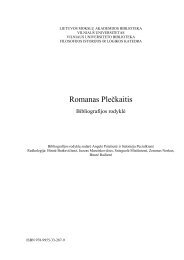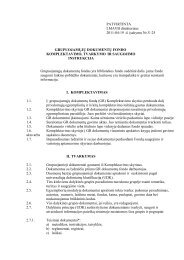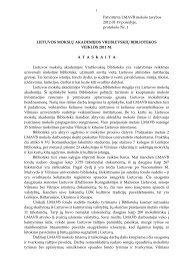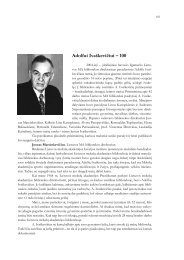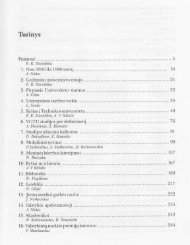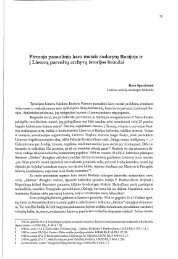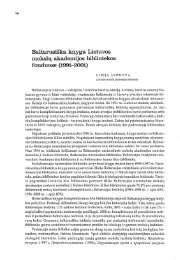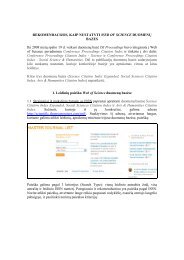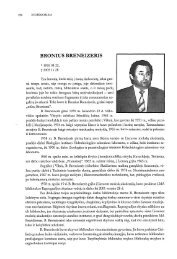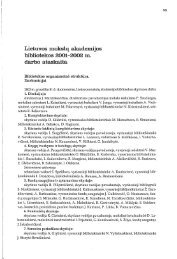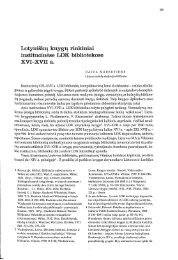BALYS SRUOGA - TRADITIONAL AND CONTEMPORARY ...
BALYS SRUOGA - TRADITIONAL AND CONTEMPORARY ...
BALYS SRUOGA - TRADITIONAL AND CONTEMPORARY ...
You also want an ePaper? Increase the reach of your titles
YUMPU automatically turns print PDFs into web optimized ePapers that Google loves.
<strong>BALYS</strong> <strong>SRUOGA</strong> -<strong>TRADITIONAL</strong><strong>AND</strong><strong>CONTEMPORARY</strong>CONCEPTIONSummaryThe object of the research are featuresof Balys Sruoga's works of literarycriticism and lyrics of 1911-1929. In 1911 first letters, poems,critical essays, translations were published.For almost two decades hewrote poems, librettos, translatedclassical and modernist poetry, analyzedand assessed Lithuanian cultureand literature. After 1929 Sruoga'sinterests departed to a new field,the field of theatre activity, performancereviews, organization of theatreseminars and studies, creationof dramas. Sruoga's literary piecesof the two decades reveal most importantimpulses of the modernityepisteme, although these pieces combinedifferent experiences and arecontradictory. It has a characteristic184 185
structure of early fin-de-siecie Modernism, where Realistic and Romanticelements are interwoven with Impressionistic, Symbolist, Neoromanticand Decadent ones.Recently, the research of the sources of Modernist Lithuanian literatureas well as the concept of Modernism itself became highly relevant.The research encourages the comprehension of the national literaturewithout resort to positivist values and methods, but turning to othermeans. Applying the notion of modernity episteme, activated by Postmodernists(M. Foucault, A. Giddens, F. Jameson, P. Childs), the dissertationtypologises and refines the traditional notion of Lithuanian Modernism.The model of three long epistemes of cultural development(Classical, Modernist, Postmodernist), indicated by F. Jameson, is adopted.The beginning of the Modernist episteme is assigned to the 18 thсEnlightenment and Romanticism, which took the place of the Classicalepisteme based on taxonomy and mimesis. It ended in the 7 thdecade ofthe 20 thс giving way to the new post-industrialist literature and Postmodernism.Theoreticians of Postmodernism view literary Modernism notas a narrow immanent trend, but as an extensive part of the episteme ofmodern culture, where the idea of creative and aesthetic power of asubject gained ground.Theoreticians of Postmodernism urge to interpret Romanticist, Realistand Modernist literature trends of the 19 thс as parts of the samemodern cultural episteme, emphasizing their similarities rather than differences.The Modernism adopted the essential assessment criteria of aRomantic creative work (novelty of art form, unconventionality, inspiration)as well as the major postulate of anthropological aesthetics (naivety,surprise, spontaneity of personality combined with subjectivism, individualism,phychologism, peculiarity of creative nature). The strategy ofthe Realism emerged as the most modern one and expanded along withthe processes of secularization of society. It denied the obsolete Romanticmysticism. Realists highlighted the societal engagement of the creatorand for this reason they were involved in a heated polemics over theprocesses of modernization, thus instigating them.The later stage and the end of modernity episteme in culture wereshaped under the influence of K. Marx, F. Nietzsche and S. Freud. Mo-demist literature made a cliche out of the idea of alienation broughtforward by Marxists. The pessimistic treatment of A. Schopenhauer'screative works, Nietzsche's vitalistic theory of art moulded the society'sconception of „spiritual crisis", emphasized the Apollonian and Dionysiantypes of human nature and experience. This Nietzsche's insight becamethe starting point of modern culture and art (both Symbolist andAvant-garde) as well as the axis of considerations. Psychoanalytic worksof Freud persuaded many writers that the protagonist of a creativework (just like its author) is a contradictory, often unstable and fragmentedpersonality. The true essence of such a personality lies in itssmothered sexual complexes. The following theories were essential forthe formation of the modernity episteme: Ch. Darwin's Theory of Evolution,A. Einstein's Theory of Relativity, M. Heidegger's Theory ofOntological Hermeneutics. The ideas of modernity, which came intobeing in the beginning of the 17 th с throughout the entire 19 th с promotedthe expression of freeing the individual creative self-consciousness,which reached its acme and limit in the Avant-garde creation. Writingwas treated as a linguistic experiment; being became the „house of language";there was a tendency to elimin-ate tradition from a piece of creativework. It promoted dehumanized, formalist art and formalist ways ofcomprehending and interpreting the creative process, which smotheredModernist subjectivism and aesthetics.A Survey of Modernist Poetry (1927) by R. Graves and L. Ridingoffers distribution of literary Modernism into two stages. The first stageextended till the second part of the 19 thc; it is otherwise called fin-desiėcleModernism. Its beginning is associated with the works of Ch.Baudelaire and G. Flaubert, its ending — with the creative heritage ofS. Mallarmé. Stage two is the Avant-garde movement of the 20 th с Thetypological model of early Modernism including Impressionism, Symbolism,Neo-Romanticism, Secession, Aesthetism, and Decadence is morecha-racteristic of Sruoga and his contemporaries. It is stylistically heterogeneousModernism enjoying strong ties with Romanticism. It has acharacteristic feature of internalization of action and world perception,when the perception of reality is emphasized rather than the objectivereality itself. The poetics of Symbolism was especially relevant in this186187
context. It consolidated Romanticist, Realistic, Naturalist, Impressionistand Decadence elements and along with Impressionism broke the rhetoricform of language.The analysis of reception of Sruoga's Modernism in Lithuanian literarytheory and criticism of the 20 thс showed that in the first half of the20 th с critics valued Sruoga first of all as a representative of new stylistictrends (Impressionism, Symbolism, Neoromanticism), novel worldviewtendencies (Decadence and Aesthetism) and the new trend (Modernism)embracing all aforementioned ones. Sruoga was interpreted by the criticsas a simultaneous follower of the multi-trend Western European fin-desiecleas well as Russian Modernism, but through their implication intothe tradition of the spirit and culture of his nation and having sensed theimpulses of his own creative consciousness. In the second half of the 20 thсsome researchers connected Sruoga's Modernism with the concrete trendof Symbolism, others - with Neoromantic Symbolism, implicating thevariety of movements of the Western fin-de-siecle Modernism. Therefore,it is claimed that it is worth suggesting a conception of Postmodernistheterogeneous Modernism in Sruoga's creation.Sruoga's criticism is a conscious creation of „New Art" theory, manifestationof Modernist creative work and, in the same time, personalmotivation and intellectual self-interpretation. Creation was interpretedfrom the point of view of psychology, history and aesthetics, and ModernistSymbolism was established as the most perfect synthesis of idealistic(Romantic) and empiric (Realistic) artistic consciousness and form, acombination of opposite origins. Sruoga's psychological treatment of artin three stages (Realism, Romanticism and Symbolism) and the interpretationof Symbolism as a universal and in the same time Modernist creativemethod leads to classical speculative, hermeneutic and formalistGerman aesthetics (I. Kant, G. Hegel, W. Dilthey, J.W. Goethe, F. Schiller,H. Wölfflin, H. Brunno, A. Boeckh adopted via P. Merkelis).Sruoga is a theorist of art symbol. He treated symbol as a sign connectionof Realistic and Romantic creative consciousnesses, sharing theintuitivist theories of A. Belyj and Viač. Ivanov. The epistemic treatmentof Sruoga's Symbolism as a revived Romanticism or Neoromanticismcoincides with V. Briusov's conception of Neoromanticism. Sruoga createda Modern lyrics having studied the neoromantic pursuit of „nationalspirit" in Lithuanian literature, having agreed with the actualization offolklore by Russian symbolists and having integrated Nietzsche's modelof Apollo / Dionysus, which was elevated in Western and Russian intuitivisttheories, into his texts.B. Sruoga's Translations of Modernists actualizes the entirety of translationsof the Lithuanian writer as a manifold, heterogeneous field ofactivity, enjoying strong ties with the Russian and Western fin-de-siecleModernism. It is viewed from the point of view of M. Bakhtin's aesthetictheory. The translations of P. Verlaine's and A. Achmatova's poemsby Sruoga are compared to the original poems. The aim is to find distinctivefeatures of the polylogue of Sruoga's translations. In addition, itallows marking the most significant guidelines of Sruoga's Modernistlyrics.Sruoga harmonized the freedom of improvisation with the requirementof artistic structure in his translations and his lyrics and, thus,merged various stylistic elements of Modernist fin-de-siecle trends, incorporateda peculiar combination of mythological past and modern present.It is considered that Sruoga's lyrics originated of intuitive, associative,anti-rhetorical, anti-narrow-minded, spontaneous, peculiar andartistic poetic thinking in Lithuania. Alongside translations it demonstratesthe ability of creating personality to accept different traditions, spontaneouslyadopt and authentically experience them.Sruoga chose poetic architectonic form seeking to make life aesthetic.The complicated self-awareness of his speaker is grounded on mythicaland Romantic worldview, the values of idealism and humanism. Thepoet expresses Weltanschauung of the speaker via his spontaneous anddynamic emotional sparks; he emphasizes it as an untypical, unusual, innovative,emotionally unstable modern individuality. The speaker is shapedin space and time via lyrical-confessional expression and partially -expressionist-ironic treatment. The space structure of the poetic world ischaracterized by fragmentary, contour features and constant change. Themodern treatment of time is rendered by fixed images, which last only fora moment; they are interwoven with the poetics and expression of folkloristiccyclic time, as well as the Romantic time of natural, eternal, mytho-188 189
logical dimensions, which is characteristic of the aesthetics of Symbolism.The poet succeeded in unfolding the „spiritual scenery" of the speakerthrough paradoxical harmony of eternity and Impressionistic blink.Via abundant solar symbols Sruoga established links with the Weltanschauungof Russian Symbolism and German Romanticism, Nietzsche'sphilosophical theory, medieval solar motifs and expressed essentialvalues of the speaker: spirituality, idealistic aestheticism, ritualism,mythologism. Sruoga used the erotic parallel of the sun / soul as a continuationof Maironis' topic of sisters and platonie love, and having transformedit Sruoga started a new tradition of erotic lyrical verse in Lithuanianpoetry.The poet formulated the concepts of modern lyricism, melodiousnessand aestheticism, and, although, he denied Maironis, he still continuedthe reform of poetry, conceived by Maironis. Sruoga substantiallyextended its expressive possibilities. So the Modernism of Sruoga's creationcould be defined more precisely with the help of extensive andepistemic meaning. Lyrics by Sruoga characterized a sensual and antirhetoric,aesthetical and intricate, illogical and polysemous language as anopposite to the prose and commonplace. Sruoga gave an unheard musicianship,variety of rhythms and phonetic sonority to the Lithuanianpoetry. The Modernist version of Sruoga's lyrics, which was mouldedbetween the poetics of Romanticism and Expressionism is stylisticallyheterogeneous and marks the general paradigm of early Lithuanian Modernism.Formalist and structuralist research of the goals of poetics were aliento Sruoga. Recently, poststructuralists spoke of a crisis of analyticalthought in literary theory, of formal linguistic analysis; they go back tothe cultural and philosophical assumptions of the text, the meaning ofreceptivity. The meaning centre of theoretical considerations is shiftedfrom language to cultural issues. Therefore Sruoga's criticism, as a dialogicand, in the same time, ironic / critical text, could be particular importantwithin the context of contemporary culturology. The poetry shouldbe assessed more as an experimental or historical phenomenon, exerciseof Lithuanian poetic word, which yielded poetic dramas and the newwave of Neoromantic poetry of already non-experimental rank.The actualized Postmodernist point of view on culture and literatureallows new interpretation of the creative heritage of any author of anyperiod. The actualized context of long historical periods allowed revealingthe new aspects of relation of early creative works of Sruoga withGerman aesthetics and Russian Symbolism, outline the peculiarity of hisModernist model and specify its place within the context of EuropeanModernist literature. The actualized Modernism conception in the contemporaryliterary theory and criticism and the creative heritage of Sruogawill make room for the researchers of literary process of the 20 thс aswell as education specialists to view and interpret the Modernism heritagein a novel way. They will be able to use the dissertation while workingon articles, monographs, compiling textbooks, study modules, to includesome statements concerning the heter-ogeneous character of Modernismin Sruoga's early creative writing into the programmes of university, higherand secondary education.190191



